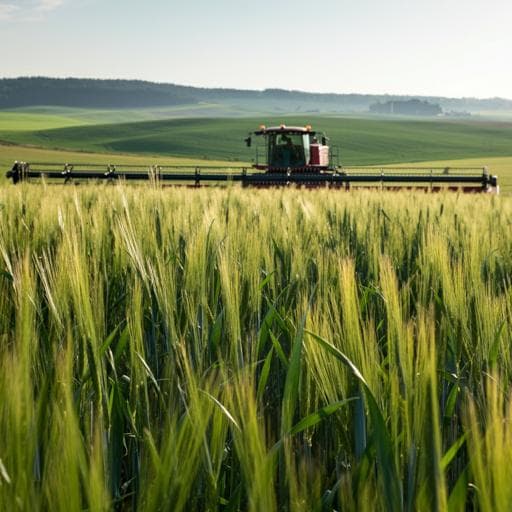
Agriculture
Time management governs climate resilience and productivity in the coupled rice-wheat cropping systems of eastern India
A. J. Mcdonald, Balwinder-singh, et al.
India aims to boost wheat production by 30% by 2050, with a focus on optimizing sowing dates. This study reveals that adjustments in sowing times can enhance wheat yield potential by 69% without impacting rice productivity. The research was conducted by an expert team including Andrew J. McDonald, Balwinder-Singh, and others.
~3 min • Beginner • English
Introduction
The study addresses why wheat yields in the Eastern Ganges Plain (EGP) of India lag behind potential despite the necessity to increase national wheat output from ~110 to 140 million tons by 2050. With minimal scope for area expansion, closing yield gaps via intensification is essential. In the Indo-Gangetic Plain’s rice–wheat (RW) system, late wheat sowing exposes the crop to terminal heat, reducing photosynthesis, grain filling duration, and yields. Although timely sowing is known to mitigate heat stress, the quantitative contribution of current sowing patterns to yield gaps and the enabling factors for adjusting planting dates are under-characterized, particularly within the coupled RW system where management trade-offs occur. The purpose is to quantify the role of sowing dates on actual yields, yield potential, and yield gaps; assess gains from sowing date adjustments; identify enabling/constraining factors for timely wheat planting; and evaluate RW system-level strategies to enhance climate resilience by managing planting dates.
Literature Review
Prior work highlights: (1) Wheat is a major staple with large future demand in India; yield intensification is required due to limited cultivable land. (2) In the Western Indo-Gangetic Plain, high wheat yields face sustainability issues (e.g., groundwater depletion) that limit intensification potential. (3) Reported causes of EGP yield gaps include late sowing, older cultivars, weeds, irrigation access, and labor constraints. (4) Heat stress around reproductive stages reduces yield; multiple studies confirm the importance of timely sowing for avoiding heat-related losses. (5) RW systems involve interlinked decisions with trade-offs, necessitating system-level rather than crop-specific perspectives. (6) Remote sensing and prior analyses have been used to estimate sowing dates and yield gaps, but contemporary, system-coupled assessments and enabling condition analyses are limited. This study builds on these strands by integrating surveys, satellite phenology, boundary line analysis, and crop simulations to quantify time management effects.
Methodology
Study area: Bihar state and seven adjacent districts in eastern Uttar Pradesh (~2.25 Mha RW system), humid subtropical climate. Rice typically transplanted early July–mid-August; wheat sown early November–late December and harvested late March–April.
Surveys:
- Household surveys (decision factors): Cluster sampling in 40 randomly selected villages across six districts of Bihar; 1,000 households surveyed (Aug–Oct 2013); 96% revisited (May–Jul 2016). Total 5,766 site-year observations (2010–2015) on establishment and harvest times; elicited reasons for delayed wheat sowing (>15 Nov).
- Landscape Diagnostic Surveys (LDS; determinants of productivity): Five seasons (2012–2017), purposive sampling with CSISA-associated farmers and neighbors, 6,216 site-years; crop cuts at harvest (three 2×1 m plots). In 2017–2018, a representative two-stage random sample across AOI (30 villages/district; seven households/village) yielded 7,648 fields with comprehensive biophysical, management, socio-economic data and self-reported yields; digital soil property maps added for 2018.
Analytics:
- Boundary line analysis: Estimated attainable wheat yield potential (Yp) as a function of sowing date by binning data in 5-day intervals, extracting 90th percentile yield per bin, and fitting a piecewise linear regression across six years (2013–2018) using the ‘Segmented’ R package. Interannual variability assessed via SD of means per 5-day period.
- Machine learning: Random Forest (boosted forest in JMP Pro v14) models (separate models for 2013–2017 and 2018 due to survey design differences) to predict yield and rank factor importance through recursive permutation.
Remote sensing (satellite-based crop assessment):
- MODIS EVI time series (Terra MOD13Q1 and Aqua MYD13Q1, 250 m; 16-day composites analyzed at 8-day steps) for 16 years (2002–2017 wheat seasons). TIMESAT Savitzky–Golay used to derive phenology: sowing (start of season), maturity (end), and duration. Wheat area masking used thresholds and seasonality to separate wheat from other vegetation and crops; validated against 201 ground points with 86% accuracy (wheat vs non-wheat).
- Sowing date correction: From LDS ground truth, 15% of maximum EVI is reached ~3 weeks after sowing; thus, a 3-week backward adjustment from 15% max EVI date estimated true sowing.
Scenario analysis for sowing date adjustments:
- Defined four scenarios at 250 m pixel level using the boundary line model: Scenario A (current mean sowing date), Scenario B (wheat-focused interventions; 7-day advancement), Scenario C (rice-focused interventions; 14-day advancement via DSR, earlier transplanting, shorter-duration hybrids), Scenario D (combined rice+wheat; 21-day advancement). Assumptions: 11% of fields (≥25 Dec mean sowing) are too wet to advance (binding drainage constraint); no sowing before 27 Oct.
- Computed Yp and yield gaps (YG = Yp − Ya) with Ya from 2018 survey (2.9 t ha−1); aggregated production and revenue gains across 2.25 Mha using minimum support price (17.35 INR kg−1; 1 USD = 77.51 INR as of May 2022).
Cropping system simulations (APSIM v7.09):
- Single-site simulation (Patna, Bihar) using WHEAT and ORYZA modules; calibrated with ICAR experimental site data; silt loam soil; dynamic hydraulic conductivity to represent puddled rice to dryland wheat transition.
- Varieties: Rice MTU7029 (155 d, inbred; long-duration) and Arize6444 (135 d, hybrid; medium-duration); Wheat PBW343.
- Weather: 43 years (1970–2013) daily data; management reflects best practices for densities, fertilization; rice irrigation to maintain ponding initially, then irrigated 3 days after disappearance of ponded water; wheat irrigated at 50% depletion in top 60 cm. Wheat sown 15 days after rice harvest. Outputs: yields, interannual stability, irrigation water, gross margins across transplanting dates (June–mid-September in 7-day increments).
Ethics and data: Research complied with CIMMYT ethics policy; data sources and repositories specified for LDS, household surveys, MODIS data, and APSIM inputs/outputs.
Key Findings
- Sowing date dominates yield outcomes: Random Forest models for both 2013–2017 and 2018 identified wheat sowing date as the strongest predictor of yield.
- Sowing patterns and yields (2018): Median sowing 27 Nov (IQR 20 Nov–5 Dec). Mean Yactual = 2.9 t ha−1. Early sowing (<20 Nov) mean = 3.4 t ha−1; mid (20 Nov–4 Dec) near average; late (>4 Dec) mean = 2.5 t ha−1. Early sowing achieved ~0.9–1.0 t ha−1 (≈36%) higher yield than late.
- Yield potential vs sowing date: Piecewise boundary line with breakpoint DOY 324 (20 Nov). Before 20 Nov, each day delay reduces Yp by ~25 kg ha−1 d−1; after 20 Nov, losses double to ~51 kg ha−1 d−1. Fields sown early Nov have Yp ≈ 5.4 t ha−1 vs late Dec ≈ 3.2 t ha−1, a 69% difference. Interannual Yp variability increases by ~30% after 20 Nov, indicating lower reliability with late sowing; very late mid-Dec sowing stabilizes at consistently low Yp.
- Regional sowing from satellites (2003–2017): Mean sowing ≈ 13 Dec (yearly range ~5–19 Dec; SD ±4 d). Within-year pixel-level SD ≈ ±11 d. 59% of wheat area sown after 1 Dec; geographic delays notable in the southwest, earlier in northwest/central AOI.
- Drivers of late wheat sowing (2010–2015; n=5,766 site-years; 4,857 late, 84%): Top reasons: field still occupied by previous crop (44%, mainly rice), lack of awareness of early sowing benefits (26%; fell from 37% to 14% between 2010–2012 and 2013–2015), field waterlogging/poor drainage (21%). Extension advice, capital, labor, and seed availability were minor factors. In 2018 LDS, after 1 Nov, each 1-day delay in rice harvest delayed wheat sowing by ~0.8 day; median rice harvest–to–wheat sowing lag was 15 days (upper quartile ≥23 days).
- Scenario-based gains (across 2.25 Mha): Baseline mean wheat Yt (Scenario A) = 3.68 t ha−1; Scenario B (wheat-only) = 3.98; Scenario C (rice-only) = 4.26; Scenario D (rice+wheat) = 4.52. Yield gap (YG, t ha−1): 0.78 (21%) baseline; 1.08 (27%) B; 1.36 (32%) C; 1.62 (36%) D, reflecting higher Yp with earlier sowing. Production gain by closing YG (t yr−1): 1,760,069 (A); 2,426,514 (B); 3,063,936 (C); 3,642,316 (D). Farmgate revenue gain by closing YG (USD yr−1): $393,977,547 (A); $543,155,988 (B); $685,837,890 (C); $815,303,655 (D). Scenario D adds ~1.88 million t and ~$421 million per year over baseline.
- System simulations (APSIM): To preserve wheat Yp (plant before 20 Nov), long-duration rice must be transplanted on or before ~13 July on average; delays sharply reduce system productivity and gross margins (>25% decline with a two-week delay), with increasing irrigation needs. Medium-duration hybrid rice offers a broader near-optimal transplanting window (15 June–3 Aug) with similar yields and margins, while enabling timely wheat sowing.
- Spatial opportunity: Largest potential wheat Yt gains (>1.0 t ha−1) concentrated in the northern half of the AOI; modest benefits in the southwest where sowing is very late.
Discussion
The findings show that time management—specifically advancing wheat sowing—substantially enhances wheat yields, yield potential, and interannual stability in the EGP, offering a practical pathway to climate resilience. Managing rice and wheat as a coupled system is essential: timely wheat is strongly constrained by rice harvest timing, and interventions in rice establishment (earlier transplanting, direct seeding, shorter-duration cultivars) can unlock wheat sowing advances without compromising system-level productivity or profitability. As the cool-season window narrows with climate change, the benefits of timely wheat establishment will likely increase. Spatial analyses point to priority zones (northern AOI) for targeting interventions. Adoption requires addressing enabling conditions: affordable and reliable irrigation/energy (e.g., electrification), mechanization and service provision to reduce turnaround time, improved agro-advisories harnessing subseasonal forecasts, and broader diffusion of medium-duration hybrid rice and combine harvesting where suitable. Given socio-economic and institutional constraints, system-level, context-specific strategies, purposeful targeting (e.g., household typologies, ex-ante adoption tools), and socio-technical innovation bundles are needed to scale earlier planting practices effectively.
Conclusion
Time management of the rice–wheat cropping calendar—especially advancing wheat sowing by aligning rice management—governs climate resilience and productivity in eastern India. Advancing sowing dates can raise wheat yield potential by ~0.84 t ha−1 on average (versus current mean dates), expand the attainable yield gap by ~69%, and, if closed, deliver ~1.88 million additional tons and ~$421 million in annual farmgate revenue across 2.25 Mha, without sacrificing rice productivity or profitability. Transformative gains hinge on treating rice and wheat as a coupled system and prioritizing interventions that ensure wheat planting before ~20 November. Future work should refine subregional targeting with improved soil/drainage mapping and develop scalable socio-technical bundles (mechanization services, irrigation access, hybrid rice, advisories) to mainstream timely planting as climate adaptation intensifies with warming.
Limitations
- Representativeness and scale: APSIM simulations were conducted for a single site (Patna) without subregional variation in soils or climate; optimal dates may vary locally.
- Data constraints: 2018 yields were farmer-reported (versus crop cuts in earlier years), contributing to lower model R2 and modest RMSE improvements; satellite sowing dates require a 3-week correction (early growth not directly observable).
- Scenario assumptions: Treated ~11% of fields (≥25 Dec mean sowing) as non-advanceable due to poor drainage; assumed no wheat planting before 27 Oct; actual constraints may vary by year and location.
- Model verification: APSIM application relied on prior validations in Asia; additional site-specific verification was not reported.
- Adoption and feasibility: Analysis of enabling factors indicates socio-economic and institutional barriers (e.g., service access, irrigation costs) that may limit scaling; these were not experimentally addressed within this study.
Related Publications
Explore these studies to deepen your understanding of the subject.







